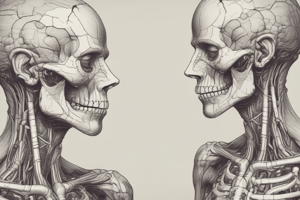Podcast
Questions and Answers
What is the primary function of sweating in the human body?
What is the primary function of sweating in the human body?
- To regulate body temperature (correct)
- To remove waste products
- To regulate body pH
- To maintain skin hydration
What is the composition of sweat?
What is the composition of sweat?
- Primarily salts and amino acids
- Primarily water and carbohydrates
- Primarily proteins and acids
- Primarily water and electrolytes (correct)
What is the pH of sweat?
What is the pH of sweat?
- Neutral, with a pH of 7
- Acidic, with a pH of 4-6 (correct)
- Basic, with a pH of 7-9
- Alkaline, with a pH of 10-12
What type of stimuli can trigger sweat glands to secrete sweat?
What type of stimuli can trigger sweat glands to secrete sweat?
What is the approximate percentage of proteins in sweat?
What is the approximate percentage of proteins in sweat?
How many sweat glands are distributed throughout the human dermis?
How many sweat glands are distributed throughout the human dermis?
What is the primary function of sweat glands in the body?
What is the primary function of sweat glands in the body?
Where are apocrine sweat glands primarily found in the body?
Where are apocrine sweat glands primarily found in the body?
What type of sweat glands are distributed over the entire body, with a few exceptions?
What type of sweat glands are distributed over the entire body, with a few exceptions?
What is the role of the hypothalamus in thermoregulatory sweating?
What is the role of the hypothalamus in thermoregulatory sweating?
What type of neurotransmitter is involved in the stimulation of eccrine sweat glands?
What type of neurotransmitter is involved in the stimulation of eccrine sweat glands?
What is the main difference between apocrine and eccrine sweat glands in terms of their structure?
What is the main difference between apocrine and eccrine sweat glands in terms of their structure?
During which phase of life do apocrine sweat glands increase in size?
During which phase of life do apocrine sweat glands increase in size?
What type of sweat glands are thought to arise from eccrine glands during puberty?
What type of sweat glands are thought to arise from eccrine glands during puberty?
What is the primary source of excessive perspiration in the body?
What is the primary source of excessive perspiration in the body?
What is the main function of acetylcholine in thermoregulatory sweating?
What is the main function of acetylcholine in thermoregulatory sweating?
Which of the following factors is thought to increase thermoregulatory sweating?
Which of the following factors is thought to increase thermoregulatory sweating?
What is the characteristic of the secretory portion of apoeccrine sweat glands?
What is the characteristic of the secretory portion of apoeccrine sweat glands?
What is the characteristic of pathological sweating or hyperhidrosis?
What is the characteristic of pathological sweating or hyperhidrosis?
Which of the following structures is involved in regulating involuntary movement?
Which of the following structures is involved in regulating involuntary movement?
In which condition is excessive sweating most likely to occur at distinct anatomical sites?
In which condition is excessive sweating most likely to occur at distinct anatomical sites?
What is the percentage of apoeccrine sweat glands in the armpit region of some focal hyperhidrosis patients?
What is the percentage of apoeccrine sweat glands in the armpit region of some focal hyperhidrosis patients?
What is the maximum capacity of eccrine glands to produce sweat per day?
What is the maximum capacity of eccrine glands to produce sweat per day?
What is the rate of sweat production per hour when a person is exposed to heat or exercise?
What is the rate of sweat production per hour when a person is exposed to heat or exercise?
What causes the increase in sweat production during the initial phase of sweating?
What causes the increase in sweat production during the initial phase of sweating?
What is the function of dark cells in eccrine glands?
What is the function of dark cells in eccrine glands?
What triggers the series of electrolyte exchanges in eccrine gland cells?
What triggers the series of electrolyte exchanges in eccrine gland cells?
What is the primary solution produced by the eccrine gland?
What is the primary solution produced by the eccrine gland?
What is the function of apocrine glands in other mammals?
What is the function of apocrine glands in other mammals?
What is the composition of the solution secreted by apocrine glands?
What is the composition of the solution secreted by apocrine glands?
What is the role of sodium pumps in the eccrine gland cells?
What is the role of sodium pumps in the eccrine gland cells?
What is the result of the reabsorption of sodium chloride from the primary solution?
What is the result of the reabsorption of sodium chloride from the primary solution?
Flashcards are hidden until you start studying




